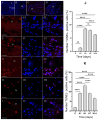Air-Exposure- and Reoxygenation-Stimulated Expressions of Caspase-3 and Induction of Apoptosis in the Central Nervous System of the Crab Erimacrus isenbeckii
- PMID: 40498002
- PMCID: PMC12154311
- DOI: 10.3390/cells14110827
Air-Exposure- and Reoxygenation-Stimulated Expressions of Caspase-3 and Induction of Apoptosis in the Central Nervous System of the Crab Erimacrus isenbeckii
Abstract
Air exposure stress during live transport and subsequent reoxygenation are factors in the development of molecular/pathological and compensatory/adaptive responses. They affect the physiological functions and survival of economically important invertebrate species, in particular, crustaceans. In this study, we consider the effects of anoxia and subsequent reoxygenation on the physiological responses, signaling pathways involved in stress, and cell apoptosis in the central nervous system (CNS) of the horsehair crab, Erimacrus isenbeckii. The results showed that 1 day of air exposure stress and 1 subsequent day of reoxygenation cause the immunoreactivity of tyrosine hydroxylase (TH) and neuropeptide Y (NPY) to change, suggesting that these changes may be associated with adaptive responses, which are presumably employed to avoid oxidative damage and provide the initial mechanism for survival. Caspase-3 immunoreactive neurons increased eight-fold in the brain and 7.2-fold in the VNC after 1 day of reoxygenation, and the TUNEL-positive cell percentage rose from 0% (control) to 8.4% in the brain and from 1.7% (control) to 13% in the VNC. The results of our study provide evidence that anoxia and reoxygenation can activate caspase-3 and facilitate apoptosis in the CNS of crabs. These results provide evidence that even short-term air exposure stress followed by reoxygenation can trigger significant apoptotic cell death in crustacean neural tissue, which is important for developing better live transport practices.
Keywords: apoptosis; caspase-3; crustaceans; dopamine.
Conflict of interest statement
The authors declare no conflicts of interest.
Figures








Similar articles
-
Effects of Chronic Exposure to Low Doses of Rotenone on Dopaminergic and Cholinergic Neurons in the CNS of Hemigrapsus sanguineus.Int J Mol Sci. 2024 Jun 28;25(13):7159. doi: 10.3390/ijms25137159. Int J Mol Sci. 2024. PMID: 39000265 Free PMC article.
-
Effects of hypoxia and reoxygenation on the antioxidant defense system of the locomotor muscle of the crab Neohelice granulata (Decapoda, Varunidae).J Comp Physiol B. 2016 Jul;186(5):569-79. doi: 10.1007/s00360-016-0976-2. Epub 2016 Mar 19. J Comp Physiol B. 2016. PMID: 26995743
-
Manganese tissue accumulation and tyrosine hydroxylase immunostaining response in the Neotropical freshwater crab, Dilocarcinus pagei, exposed to manganese.Invert Neurosci. 2017 Jun;17(2):5. doi: 10.1007/s10158-017-0198-7. Epub 2017 Apr 27. Invert Neurosci. 2017. PMID: 28451884
-
Gender identification of the horsehair crab, Erimacrus isenbeckii (Brandt, 1848), by image recognition with a deep neural network.Sci Rep. 2023 Nov 13;13(1):19190. doi: 10.1038/s41598-023-46606-x. Sci Rep. 2023. PMID: 37957197 Free PMC article.
-
Dopamine in crayfish and other crustaceans: distribution in the central nervous system and physiological functions.Microsc Res Tech. 2003 Feb 15;60(3):325-35. doi: 10.1002/jemt.10271. Microsc Res Tech. 2003. PMID: 12539162 Review.
References
-
- Mota V.C., Siikavuopio S.I., James P. Physiological responses to live air transport of red king crab (Paralithodes camtschaticus) Fish. Res. 2021;237:105882. doi: 10.1016/j.fishres.2021.105882. - DOI
-
- Cheng W., Liu C.H., Kuo C.M. Effects of dissolved oxygen on hemolymph parameters of freshwater giant prawn, Macrobrachium rosenbergii (de Man) Aquaculture. 2003;220:843–856. doi: 10.1016/S0044-8486(02)00534-3. - DOI
-
- Linh N.V., Khongcharoen N., Nguyen D.H., Dien L.T., Rungrueng N., Jhunkeaw C., Sangpo P., Senapin S., Uttarotai T., Panphut W., et al. Effects of hyperoxia during oxygen nanobubble treatment on innate immunity, growth performance, gill histology, and gut microbiome in Nile tilapia, Oreochromis niloticus. Fish Shellfish Immunol. 2023;143:109191. doi: 10.1016/j.fsi.2023.109191. - DOI - PubMed
MeSH terms
Substances
LinkOut - more resources
Full Text Sources
Research Materials
Miscellaneous

